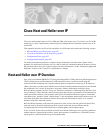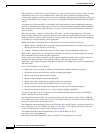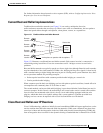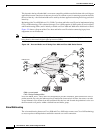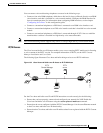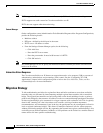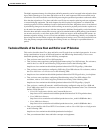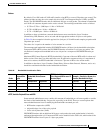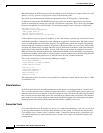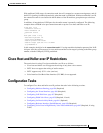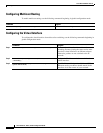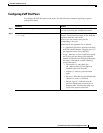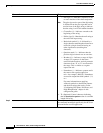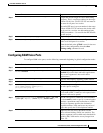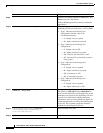
Cisco Hoot and Holler over IP
Hoot and Holler over IP Overview
VC-830
Cisco IOS Voice, Video, and Fax Configuration Guide
Note IP/TV support for Cisco hoot and holler over IP uses only G.711 u-law (mu-law) encoding.
IP/TV supports one audio stream for Cisco hoot and holler over IP.
IP/TV does not support arbitration and mixing.
Content Manager
On the configuration screen (Administration Tool>Scheduled Programs>New Program>Configuration),
provide the following details:
• Multicast address
• RTP port—defined by the dial peer in the router
• IP/TV server—IP address or name
• From the Settings>Content Manager option, do the following:
–
Click Add New.
–
Enter the IP/TV server name.
–
Enter the port number. It must be 80 because it is HTTP.
–
Click OK and exit.
Note In Content Manager, be sure to specify the multicast IP address and RTP port for the Cisco hoot and
holler over IP session.
Interactive Voice Response
The Cisco hoot and holler over IP feature can support interactive voice response (IVR) as a means of
authentication, authorization, and accounting (AAA) control. See the “Configuring TCL IVR
Applications” chapter in this configuration guide or refer to the Cisco IOS Voice, Video, and Fax
Command Reference for more information.
Migration Strategy
To aid troubleshooting and allow for regionalized hoot and holler conferences, most hoot and holler
networks today are structured by interconnecting multiple regional hoot networks with a centralized
bridge. The regional hoot networks are built using either carrier-based multidrop circuits or point-to-
point circuits bridged by the customer. All of these circuits are connected through patch panels that allow
for these regional bridges to be connected for a larger corporate-wide conference call. This is typically
done for the “morning call” that is broadcast to all locations, advising of market movements,
recommendations, and commentary. Later in the day, the patch panel may be reconfigured to allow for
local or regional conference bridges. This allows for multiple conference calls for various purposes,
without provisioning multiple circuits. By segmenting the network into regions, troubleshooting is also
easier because any audio disturbance, feedback, or level problems can be isolated to a smaller subset of
remote offices for more specific troubleshooting.



